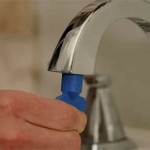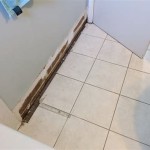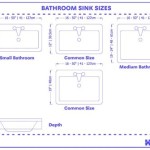How to Fill the Gap Between a Bathroom Vanity and Wall
A gap between a bathroom vanity and the wall is a common sight in many bathrooms. This unsightly gap can make the room feel less than polished and can even become a haven for dust and grime. Fortunately, filling this gap is a relatively simple task that can be accomplished with a variety of materials and techniques.
The most common reasons for gaps appearing between vanities and walls include:
- Uneven walls: Walls are rarely perfectly smooth, and even minor irregularities can result in a noticeable gap.
- Improper installation: If the vanity is not installed properly, the gap can be exacerbated.
- Expansion and contraction: Wood and other materials used in vanities can expand and contract with changes in temperature and humidity, leading to variations in size and potential gaps.
- Movement in the floor: If the floor moves or settles, it could cause the vanity to shift and create a gap.
Regardless of the reason for the gap, there are several solutions available to address it.
1. Caulk
Caulk is a versatile material that can be used to fill gaps in various applications. It is readily available at hardware stores and comes in a range of colors to match your bathroom decor. To use caulk, follow these steps:
- Clean the gap: Remove any dirt, debris, or loose material from the gap using a damp cloth or a vacuum cleaner.
- Apply caulk: Squeeze the caulk into the gap, using a smooth, even motion. Make sure to fill the gap completely.
- Smooth the caulk: Use a damp finger or a caulk tool to smooth out the caulk and create a clean, finished look. Remove any excess caulk.
- Allow to dry: Let the caulk dry completely according to the manufacturer's instructions. This typically takes 24 hours.
Caulk is a cost-effective and quick solution for filling small gaps. However, it is not suitable for large gaps or areas where the vanity moves frequently.
2. Wood Filler
Wood filler is a paste-like material that hardens to resemble wood. It is ideal for filling larger gaps and can be sanded and painted to match the vanity. To use wood filler:
- Prepare the gap: Clean the gap thoroughly and remove any loose material.
- Apply wood filler: Use a putty knife or a similar tool to apply the wood filler to the gap. Make sure to pack it in tightly.
- Let it dry: Allow the wood filler to dry completely according to the manufacturer's instructions. This may take several hours or even overnight.
- Sand and paint: Once dry, sand the wood filler smooth and then paint it to match the vanity.
Wood filler is a durable solution for filling gaps, but it requires more time and effort than caulk. It is also not suitable for gaps that are exposed to moisture, such as those below the vanity.
3. Shims
Shims are thin pieces of wood or plastic that can be used to level and stabilize the vanity. They are often used in conjunction with caulk or wood filler to create a more secure and aesthetically pleasing result. To use shims:
- Identify the problem area: Determine where the vanity is uneven and causing the gap.
- Insert shims: Place shims between the vanity and the wall to raise the vanity to the desired level. Use a hammer to gently tap the shims into place.
- Secure the shims: Once the vanity is level, secure the shims in place with wood glue or screws.
- Fill the gap: Once the shims are in place, fill the remaining gap with caulk or wood filler as described above.
Shims are a great way to fix uneven walls and ensure the vanity is level. They can also help to prevent future movement and gaps.
4. Replacing the Vanity
In some cases, the gap may be too large or the vanity may be too damaged to repair. If this is the case, the best solution is to replace the vanity altogether. This will ensure that the new vanity is installed properly and that the gap is eliminated.
When choosing a replacement vanity, consider the size of the space, the style of your bathroom, and the budget. Ensure that the new vanity is installed by a qualified professional to prevent future problems.
Filling the gap between a bathroom vanity and the wall is a simple yet essential task that can significantly improve the appearance and functionality of your bathroom. By choosing the right method for your situation, you can achieve a seamless and polished look that will enhance the overall aesthetic of your bathroom.

4 Ways To Fix A Gap Between Vanity And Wall

How To Fill Gap Between Vanity And Wall 7 Solutions

How To Fill Gap Between Vanity And Wall

Big Gap Between Vanity And Wall

4 Ways To Fix A Gap Between Vanity And Wall

How To Fill The Gap Between Vanity And Wall A Detailed Guide Funktional Home

How To Fix This Gap Between Vanity And Wall Backsplash Countertop Bathroom Sink
Gap Between Wall And Bathroom Vanity Wondering If I Can Tile Ceramic Advice Forums John Bridge
:max_bytes(150000):strip_icc()/4-filler_strip-56a4a2725f9b58b7d0d7ee38.jpg?strip=all)
Cabinets Level Wall Is Not Wood Dallas Makerspace Talk

How To Fill A Gap Between Vanity And Side Wall Baseboard Issue Too
Related Posts







